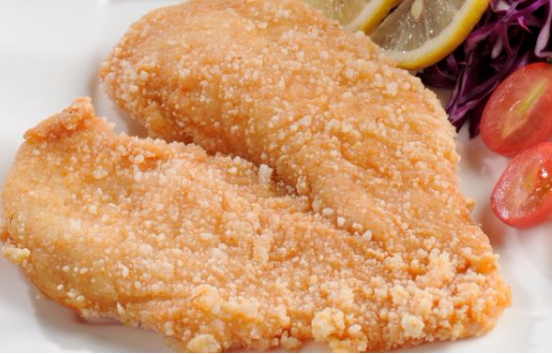Effects of tumbling parameters on the yield of conditioned chicken products
Water retention is an important indicator for judging the quality of the tumbling effect in the tumbling process. It means that when the muscle is subjected to external forces (pressure, chopping, freezing, thawing, storage, processing, etc.) moisture capacity. Existing studies have shown that properly increasing the tumbling mileage and vacuum degree can improve the water retention of meat products, and the change of the vacuum degree will have an impact on the quality and yield of beef. On the one hand, there are few reports on the effect of vacuum degree and temperature on chicken products, and tumbling mileage, temperature, and vacuum degree are important parameters in the tumbling process.

1. Test material
Chicken breast, sodium chloride, sugar, monosodium glutamate, sodium tripolyphosphate, trisodium phosphate, etc.
2. Craft
Chicken breast → trimming → rolling, kneading and marinating → steaming → forming → refrigerating
3. Related parameter analysis
3.1 Effects of tumbling mileage on marinating absorption rate and yield rate of conditioned chicken breast meat products
Through the experimental treatment, with the increase of tumble-kneading mileage, the yield of the product showed an upward trend. Compared with the 2000m tumbler treatment and the 1000m treatment, the yield increased significantly; the difference between the 2000m treatment and the 3000, 4000, and 5000m treatment was not significant. The pickling absorption rate also showed an upward trend with the increase of tumbling mileage. Compared with the 1000 and 2000m treatments, the yield of the 3000m treatment increased significantly; the difference between the 3000m treatment and the 4000 and 5000m treatments was not significant. In addition, some studies have shown that the optimal tumbling mileage in the tumble-kneading process parameters for conditioning duck breast meat products is 3000m. It can be seen that increasing the tumble-kneading mileage within a certain range can help improve the water retention of the product. However, when the tumble-kneading mileage continues Increase, the water retention will not continue to improve, this is because the tumbling loosens the muscle tissue, accelerates the penetration of the pickling liquid into the meat and makes it evenly distributed, and at the same time promotes the rupture of the tissue on the surface of the meat and the dissolution of myofibrillar proteins. , the viscous matrix produced by the degradation forms grid spaces and fixes the free water, thereby improving the water retention of the product. Therefore, considering the pickling absorption rate, yield rate and economic principles, it is ideal to choose 3000m for the tumbling mileage.
3.2 Influence of vacuum degree on marinating absorption rate and yield rate of conditioned chicken breast meat products
Compared with 0.10MPa tumbling treatment and 0.08MPa treatment, the yield decreased significantly, while the difference between 0.08MPa treatment and 0.06, 0.04, 0.02MPa treatment was not significant. The pickling absorption rate first increased and then decreased with the increase of vacuum degree. Compared with the 0.10MPa treatment and the 0.06MPa treatment, the pickling absorption rate decreased significantly, and the difference between the 0.08MPa treatment and the 0.06MPa treatment was not significant. The research shows that the vacuum degree of beef tumbling should be 0.06MPa. It can be seen that the water retention of the product does not increase with the increase of the vacuum degree. This is because a certain degree of vacuum can make the muscle fibers form pressure inside and outside. This makes the muscle fibers loose and accelerates the absorption of the pickling liquid, but too high a vacuum will cause excessive precipitation of the juice in the chicken breast, thereby reducing the water retention of the product. Therefore, considering the comprehensive yield and pickling absorption rate, it is ideal to choose the vacuum degree of 0.06MPa.
3.3 Influence of tumbling temperature on marinating absorption rate and yield rate of conditioned chicken breast meat products
With the increase of tumble-kneading temperature, the pickling absorption rate of the product showed an upward trend. Compared with the tumble-kneading treatment at 3℃ and the -3℃ treatment, the pickling absorption rate increased significantly, and the difference between the -3℃ treatment and the 0℃ treatment was not significant. Significantly, the difference between the 3°C treatment and the 6, 9°C treatments was also not significant. Yields did not differ significantly with increasing temperature. Some studies have also shown that microorganisms are not easy to reproduce at the tumbling temperature of 2 to 4 °C. As the temperature increases, the water retention of the product increases first and then tends to be flat. Ice crystals are likely to be formed during the process. The formation of ice crystals is not only unfavorable for the absorption of the pickling liquid by the muscles, but also the too low temperature will slow down the movement of water molecules, which will slow down the penetration of the pickling liquid. It may cause mechanical damage to the muscle tissue during the rolling process, resulting in a decrease in the water retention of the product. Therefore, considering the comprehensive pickling absorption rate and yield, it is ideal to choose a temperature of 3 °C.
When other process parameters remain the same, the best tumble-kneading process parameters of the three are: tumble-kneading distance of 3000-4000m, temperature of about 2°C, and vacuum degree of 0.06-0.07MPa. Under this process condition, the yield of the product can reach 98.32%.
